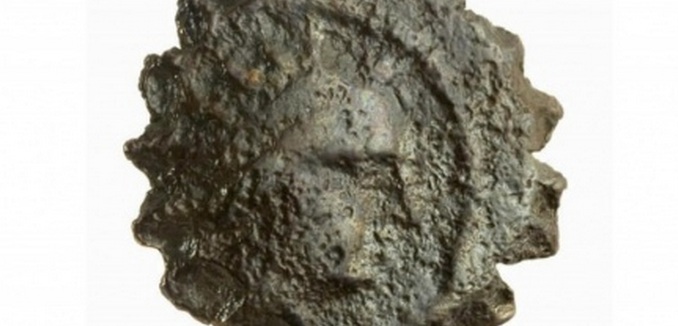A 2,000-year-old bronze coin depicting King Antiochus IV Epiphanes, the Greek tyrant under whose reign the Maccabean Revolt took place, was recently found at the Tower of David in Jerusalem, the museum announced in a statement on Tuesday.
The treasure was discovered during routine maintenance work, surprising archaeologists who believed that the historic site was completely excavated in recent decades.
Chief conservator Orna Cohen spotted the coin among the stones from a Hasmonean-era wall inside the citadel. Upon inspection, it was determined that the coin, which depicts Antiochus wearing a crown on the front and a goddess wearing a scarf on the back, was a bronze penny that was in circulation over two millennia ago.
Although no date was stamped on the artifact, antiquities officials said it was similar to thousands of others that were minted at the port city of Acre, which was called Ptolemais at the time, between 172 and 168 BCE.
“Acre seemed to like the idea of serrated coins,” IAA Coin Department head Donald Ariel told The Times of Israel. This is “the second most common coin type from the Seleucids,” he added, saying that it was only outnumbered by coins minted by Antiochus IV’s father, Antiochus III.
Antiochus IV was the king whose efforts to suppress Jewish religious observance and Hellenize Jerusalem sparked the successful Maccabean Revolt, which will be commemorated during the holiday of Chanukah next week.
Since the United Nations’ cultural organization, UNESCO, approved resolutions erasing Jewish and Christian ties to the Temple Mount earlier this year, the Israel Antiquities Authority (IAA) unearthed significant archaeological evidence attesting to that ancient heritage. In late October, the IAA presented the oldest Hebrew-language mention of Jerusalem yet discovered, dating back some 2,700 years to the time of the First Temple. Days later, Israeli archaeologists revealed that artifacts from the First Temple period had been found in situ on the Temple Mount. The week before those two announcements, the IAA said that it had located the place where Roman troops breached the walls of Jerusalem during their siege of the city and eventual destruction of the Second Temple nearly 2,000 years ago.
Evidence of the Christian history of Jerusalem also emerged in late October when the National Geographic reported that workers restoring the Church of the Holy Sepulchre claimed to have uncovered the tomb of Jesus, which was buried under layers of marble for centuries.
[Photo: Israel Antiquities Authority]





![The reverse of an ancient bronze penny, dated to the reign of King Antiochus IV Epiphanes, which was recently found at the Tower of David in Jerusalem. [Photo: Israel Antiquities Authority]](http://www.thetower.org/wp-content/uploads/2016/12/MRcoin.png)